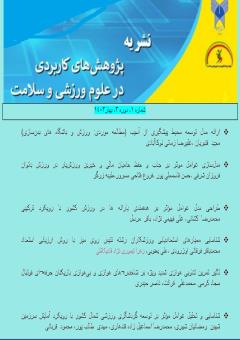طراحی مدل عوامل مؤثر بر هدفمندی یارانه¬ها در ورزش کشور با رویکرد ترکیبی
محورهای موضوعی : علوم ورزشی و سلامتمحمدرضا کشانی 1 , علی فهیمی نژاد 2 * , باقر مرسل 3
1 - دانشجوی دکتری، گروه مدیریت ورزشی، واحد شاهرود، دانشگاه آزاد اسلامی، شاهرود، ایران
2 - استادیار، گروه تربیت بدنی، واحد شاهرود، دانشگاه آزاد اسلامی، شاهرود، ایران
3 - استادیار، گروه تربیت بدنی، واحد شاهرود، دانشگاه آزاد اسلامی، شاهرود، ایران
کلید واژه: مشارکت ورزشی, هدفمندی یارانه¬ها, ورزش.,
چکیده مقاله :
هدف پژوهش حاضر طراحی مدل عوامل مؤثر بر هدفمندی یارانه¬ها در ورزش کشور با رویکرد ترکیبی بود. این پژوهش از لحاظ هدف کاربردی بوده، و روش تحقیق آمیخته از نوع اکتشافی متوالی میباشد. روش گردآوری پیمایشی بود. جامعة آماری در بخش کیفی شامل سیاستگذاران یارانه در کشور، اعضای مجلس شورای اسلامی، وزارت ورزش و جوانان و اساتید آشنا با مسئله یارانه در ورزش، شامل بودند، که بهصورت هدفمند از نوع معیاری، برای مصاحبههای کیفی در موضوع پژوهش انتخاب شدند (15 مصاحبه با 15 نفر و تا حد اشباع نظری ادامه یافت). جامعه آماری بخش کمّی ﺷﺎﻣﻞ کلیه مدیران باشگاه¬های ورزشی تهران بودند. ابزار گردآوری اطلاعات در پژوهش حاضر مصاحبه نیمه ساختاریافته و پرسشنامه محققساخته بود. بهمنظور تجزیهوتحلیل دادهها از کدگذاری در بخش کیفی و از روش معادلات ساختاری در بخش کمّی استفاده گردید. در بخش کیفی پژوهش مقوله¬ها در قالب 34 کد مفهومی و 6 مقوله اصلی استخراج شدند. در بخش کمّی نیز هر 6 مقولة اصلی پژوهش از برازش مناسبی برخوردار بودند. بنابراین، مدل پژوهش از برازش کافی برخوردار می¬باشد. با توجه به اینکه مشارکت در فعالیت¬های ورزشی، اثرات مثبت فراوانی در تمامی زوایا برای عموم مردم دارد، توصیه می¬شود که تدابیر لازم برای هدفمند نمودن یارانه¬ها در ورزش کشور، اتخاذ گردد.
The aim of the current research was to design a model of factors affecting the targeting of subsidies in sports in the country with a combined approach. This research is practical in terms of purpose, and the mixed research method is sequential exploratory. The collection method was a survey. The statistical population in the qualitative section included subsidy policymakers in the country, members of the Islamic Council, the Ministry of Sports and Youth, and professors familiar with the issue of subsidies in sports, who were selected for qualitative interviews in the research topic (15 interviews) with 15 people and continued until theoretical saturation. The statistical population of the quantitative part included all managers of sports clubs in Tehran. The data collection tool in the present study was a semi-structured interview and a researcher-made questionnaire. In order to analyze the data, coding was used in the qualitative part and the method of structural equations was used in the quantitative part. In the qualitative part of the research, categories were extracted in the form of 34 conceptual codes and 6 main categories. In the quantitative part, all 6 main categories of the research had a suitable fit. Therefore, the research model has sufficient fit. Considering that participation in sports activities has many positive effects in all aspects for the general public, it is recommended to adopt the necessary measures to target the subsidies in the country's sports.
اکبری، نعمتالله؛ طالبی، هوشنگ؛ جلائی، اعظم (1395). بررسي عوامل اجتماعي و فرهنگي مؤثر بر مصرف انرژي خانوار پس از اجراي قانون هدفمندسازي یارانهها (مطالعه موردي: شهر اصفهان). جامعهشناسی کاربردی، 27(4)، ص 1-26.
سادات الحسینی، مهدی؛ کبیرنتاج، فاطمه (1390). تأثیر هدفمندی یارانهها در ورزش کشور. در: تهران: ششمین همایش ملی دانشجویان تربیت بدنی و علوم ورزشی ایران.
صادقی، رضا؛ ظریفی، مجتبی؛ داودی، کریم (1390). بررسی تأثیر هدفمند کردن یارانهها بر میزان سطوح مشارکت افراد در برنامههای ورزشی، از دیدگاه مدیران مجموعهها و باشگاههای دولتی و خصوصی غرب تهران. در: ششمین همایش ملی دانشجویان تربیت بدنی و علوم ورزشی ایران. تهران: پژوهشگاه تربیت بدنی و علوم ورزشی.
کريمي، فرزاد؛ زاهدي کيوان، مهدی (1389). تعيين الگوي بهينه تخصیص یارانههای بخش کشاورزي به مصرفکنندگان و تولیدکنندگان. تحقيقات اقتصاد کشاورزي، 2(4)، ص 99-120.
یاری حصار، ارسطو؛ پریشان، مجید؛ حیدری ساربان، وحید (1396). ارزیابی تأثیرات هدفمندی یارانهها بر پایداری شاخصهای اقتصاد روستایی (مطالعه موردی: دهستان سردابه، شهرستان اردبیل). پژوهشهای روستایی، 8(3)، ص 536-553.
Breuer, C. & Wicker, P. (2009). Sport Development Report 2007/2008. Analysis of the sports clubs‘situation in Germany. Abbreviated Version. Cologne: Sportverlag Strau ß.
Bridget, K., Lesley, K., Adrian, E., Louise, A. & Baur, R. (2014). Identifying important and feasible policies and actions for health at community sports clubs: A consensus-generating approach. Journal of Sport Management Review, 17(1), p. 61–6.
Coates, D. & Humphreys, B.R. (2006). Proximity benefits and voting on stadium and arena subsidies. Journal of Urban Economics, No. 59, p. 285-299.
Drukker, A.J., Gayer, T. & Gold, A.K. (2020). Tax-Exempt Municipal Bonds and the Financing of Professional Sports Stadiums. National Tax Journal, 73(1), p. 157-196.
Elmose-Østerlund, K. & Iversen, E.B. (2019). Do public subsidies and facility coverage matter for voluntary sports clubs? Sport Management Review, 23(2), p. 315-329.
Fahlén, J. (2015). Sport clubs in Sweden. In: C. Breuer, R. Hoeckman, S. Nagel & H. Van derWerff (Eds.), Sport clubs in Europe. A cross-national comparative perspective (pp. 343–367). Cham: Springer.
Green, M. (2006). From ‘sport for all’to not about ‘sport’at all?: Interrogating sport policy interventions in the United Kingdom. European Sport Management Quarterly, 6(3), p. 217–238.
Parnell, D., Spracklen, K. & Millward, P. (2017). Sport management issues in an era of austerity. European Sport Management Quarterly, 17(1), p. 67–74.
Skille, E.A. (2015). Community and sport in Norway: Between state sport policy and local sport clubs. International Journal of Sport Policy and Politics, 7(4), p. 505–518.
Vos, S., Breesch, D., Késenne, S., Hoecke, J.V., Vanreusel, B. & Scheerder, J. (2011). Governmental subsidies and coercive pressures. Evidence from sport clubs and their resource dependencies. European Journal for Sport and Society, 8(4), p. 257–280.
Yuanchang, X. & Jiyu. J. (2010). The optimal boundary of political subsidies for agricultural insurance in welfare economic prospect. International Conference on Agricultural Risk and Food Security. Agriculture and Agricultural Science Procedia, No.1, p. 163-169

